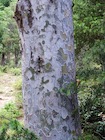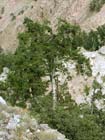
The bark peels off in oddly shaped interlocking pieces, exposing the contrasting surface of various shades of red, pink, orange, purple, white, grey, green, yellow, brown, etc. At Kalpa, India, elev. 2960 m. [Gaurav Verma, 2019.09.07, post to Facebook "Planet Conifer" group].

Tree near the Fairy Meadow trailhead out of Gilgit, Pakistan [Vladimir Dinets, 2004].

The Eurasian nutcracker, Nucifraga caryocatactes, is one of the principal seed dispersers for this species. Wikimedia Commons [Alpharius Omegon, 2019.10.10].

A tree growing at the Institute for Forest Genetics in Placerville, California [Ron Lanner].

Cones and foliage of the tree pictured above [Ron Lanner].

Conservation Status

Pinus gerardiana
Wallich ex D. Don in Lambert 1832
Common names
چلغوزا پائن noosa [Urdu]; Chilgoza pine (Lanner 1996).
Taxonomic notes
The type of three species in Pinus subsection Gerardianae, the Asian nut pines. Syn.: Pinus gerardii J. Forbes 1833 (Farjon 1998).
Description
Trees 10-20(25) m tall. Crown usually deep, wide and open with long, erect branches, but crown narrower and shallower in dense forest. Bark very flaky, peeling to reveal light greyish-green patches, similar to Pinus bungeana. Branchlets smooth, olive-green. Leaves in fascicles of 3, 6-10 cm long, finer than those of P. bungeana, spreading stiffly, sheaths falling after 1 year. Female cones 12-20 cm long, 10 cm wide when open, with wrinkled, reflexed apophyses and a umbo curved inward at the base. Seeds >2 cm long with a rudimentary wing (Farjon 1984, Richardson and Rundel 1998). The seeds are not shed but are retained by the wing adhering to the base of the scale above (Lanner 1996). See García Esteban et al. (2004) for a detailed characterization of the wood anatomy.
Distribution and Ecology
Himal: E Afghanistan, N Pakistan, India: Jammu-Kashmir, Tibet (Farjon 1998). Mostly grows in valleys at 2000-3350 m elevation (Farjon 1984), in the dry temperate forest of the inner ranges of the Himalaya, where the summer monsoon is weak and precipitation, mostly in the form of snow, rarely exceeds 1000 mm per year. In these forests it occurs with Cedrus deodara, Quercus ilex and Juniperus excelsa subsp. polycarpos (Bhattacharyya et al. 1988). Hardy to Zone 7 (cold hardiness limit between -17.7°C and -12.2°C) (Bannister and Neuner 2001).
Remarkable Specimens
Some trees have a girth of up to 4 meters (approx. 127 cm dbh) (Bhattacharyya et al. 1988). The oldest known living specimen, 747 years, was documented in a tree-ring chronology covering the period 1260-2006 (crossdated after 1290), collected in Chitral-Gol National Park, Pakistan, by Edward R. Cook, Jonathan G. Palmer, and Moinuddin Ahmed (doi.org/10.25921/2zwb-hf30). This site was used in a dendroclimatic temperature reconstruction (PAGES 2k Consortium 2013).
Ethnobotany
In Afghanistan, this species is cultivated for its edible seed (Farjon 1984), and efforts are underway to expand its economic utilization in India (Singh 1992, Singh and Chaudhary 1993). Elsewhere, native populations are ruthlessly exploited, with typically 100% of cones harvested. This harvest pressure is driven by subsistence and for the economic benefits that it provides; for example, in a good year, about 13,000 indigenous people in the Suleiman Mountains of Pakistan derive income from the nut harvest. As a consequence, there is virtually no natural regeneration of this species except in that very small fraction of its range (about 5%) where the species is inaccessible to significant human exploitation (Richardson and Rundel 1998).
A few dendrochronology studies have used this species. An exploratory study sampling trees from low, dry valley sites south of Kashmir found that most trees could be crossdated, though some specimens had too many missing rings (Bhattacharyya et al. 1988).
Observations
Vladimir Dinets (e-mail, 2004.11.14) reports that there are trees near the Fairy Meadow trailhead out of Gilgit, Pakistan. The site can be reached by "a hired jeep, or from Raikot Bridge on the Karakoram Highway by hitchhiking (early morning only). Near the trailhead are some Pinus gerardiana, Juniperus semiglobosa and Cupressus torulosa, higher up - Pinus wallichiana and Picea smithiana (slim, but up to 50 m tall). At the Meadows (5.5 km from the trailhead) there is also some Juniperus communis and J. squamata. J. semiglobosa appears again at the timberline, 5 km past the Meadows."
Remarks
Seeds are dispersed by a Eurasian nutcracker, Nucifraga caryocatactes subsp. multipunctata (Lanner 1996).
The epithet gerardiana honors the collectors, brothers Patrick, Alexander, and James Gerard, who collected plants during a military survey in India from 1823 to 1825, forwarding their collections to the East India Company botanist N. Wallich. The plant was subsequently (1839) introduced to England, where it was found to be frost-sensitive (Farjon 1984).
Citations
Bhattacharyya, A., V.C. LaMarche Jr., and F.W. Telewski. 1988. Dendrochronological reconnaissance of the conifers of northwest India. Tree-Ring Bulletin 48:21-30.
Lambert, A.B. 1832. Description of the genus Pinus, ed. 3, vol. 2: p.s.n. inter 144 & 145.
PAGES 2k Consortium. 2013. Continental-scale temperature variability during the past two millennia. Nature Geoscience 6:339-346. doi: 10.1038/NGEO1797
Singh, N.B. 1992. Propagation, selection and establishment of clonal seed orchard of Chilgoza pine (Pinus gerardiana Wall.). Indian Forester 118: 901-908.
Singh, N.B. and V.K. Chaudhary. 1993. Variability, heritability and genetic gain in cone and nut characters in Chilgoza pine (Pinus gerardiana Wall.). Silvae Genetica 42: 61-63.
See also
Elwes and Henry 1906-1913 at the Biodiversity Heritage Library. This series of volumes, privately printed, provides some of the most engaging descriptions of conifers ever published. Although they only treat species cultivated in the U.K. and Ireland, and the taxonomy is a bit dated, still these accounts are thorough, treating such topics as species description, range, varieties, exceptionally old or tall specimens, remarkable trees, and cultivation. Despite being over a century old, they are generally accurate, and are illustrated with some remarkable photographs and lithographs.
The species account at Threatened Conifers of the World.
Martin, G.J. 1995. Ethnobotany. London: Chapman and Hall.
Sehgal, R.N. and P.K. Sharma. Chilgoza: the endangered social forestry pine of Kinnaur. Nauni, India: Dr. Y.S. Parmar University of Horticulture and Forestry.





